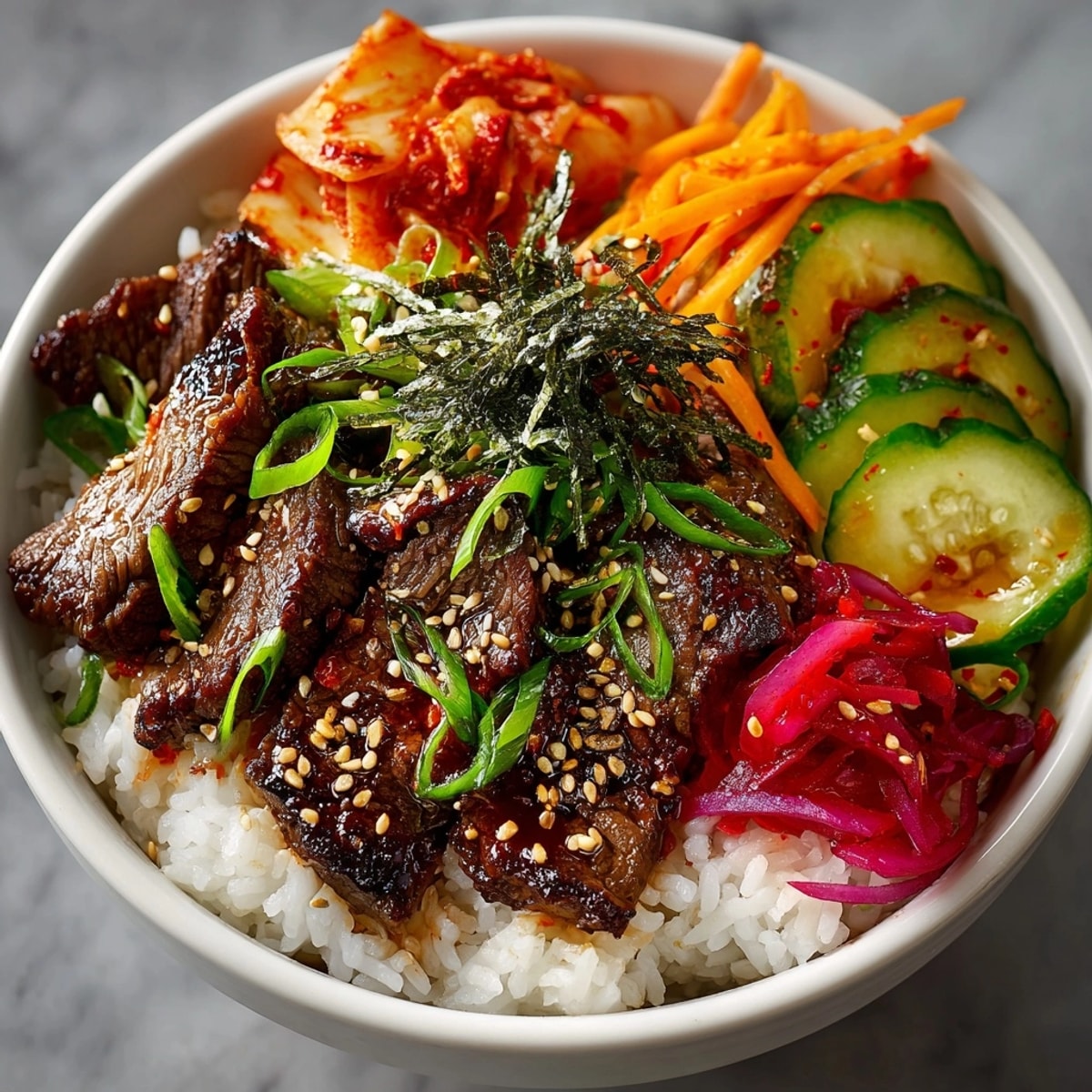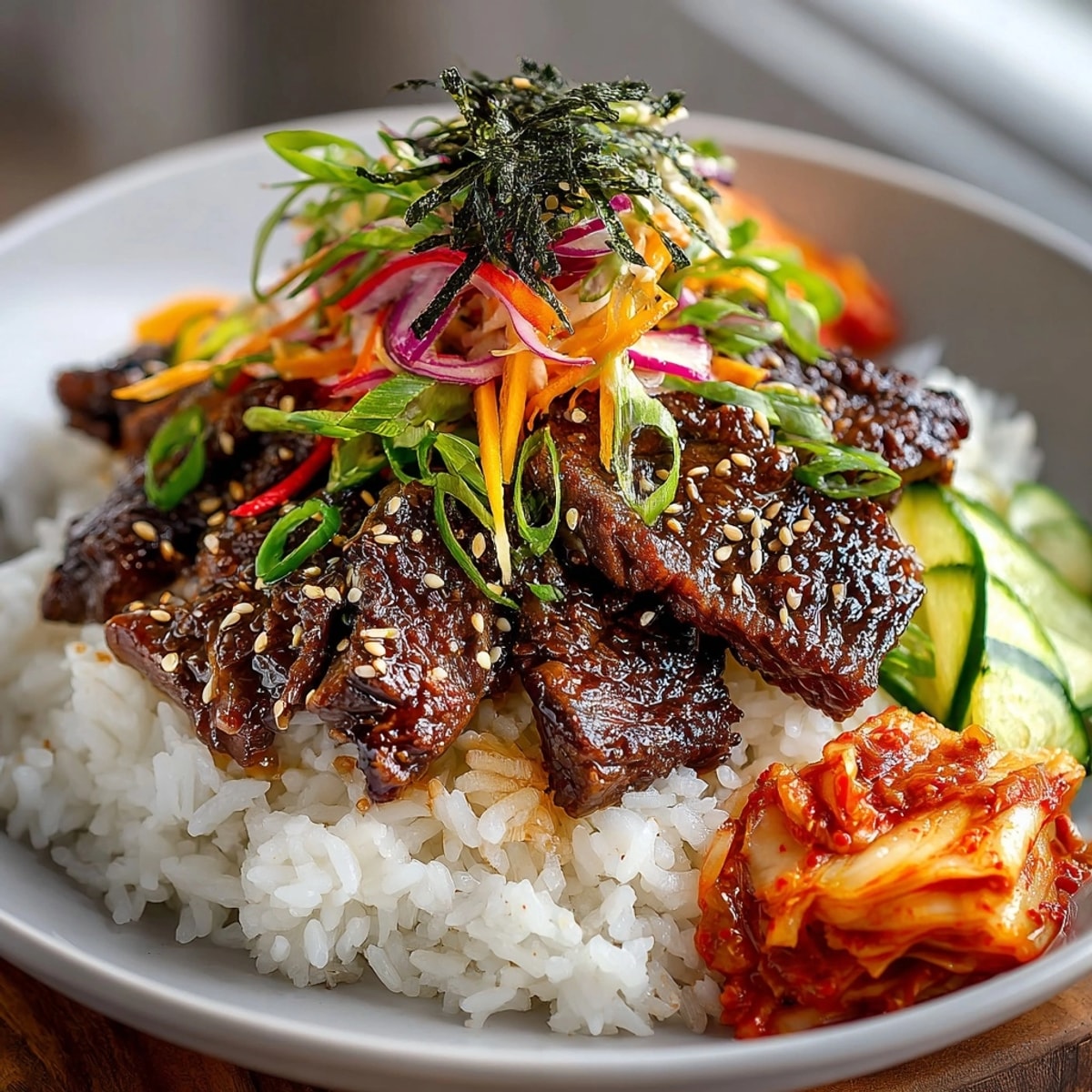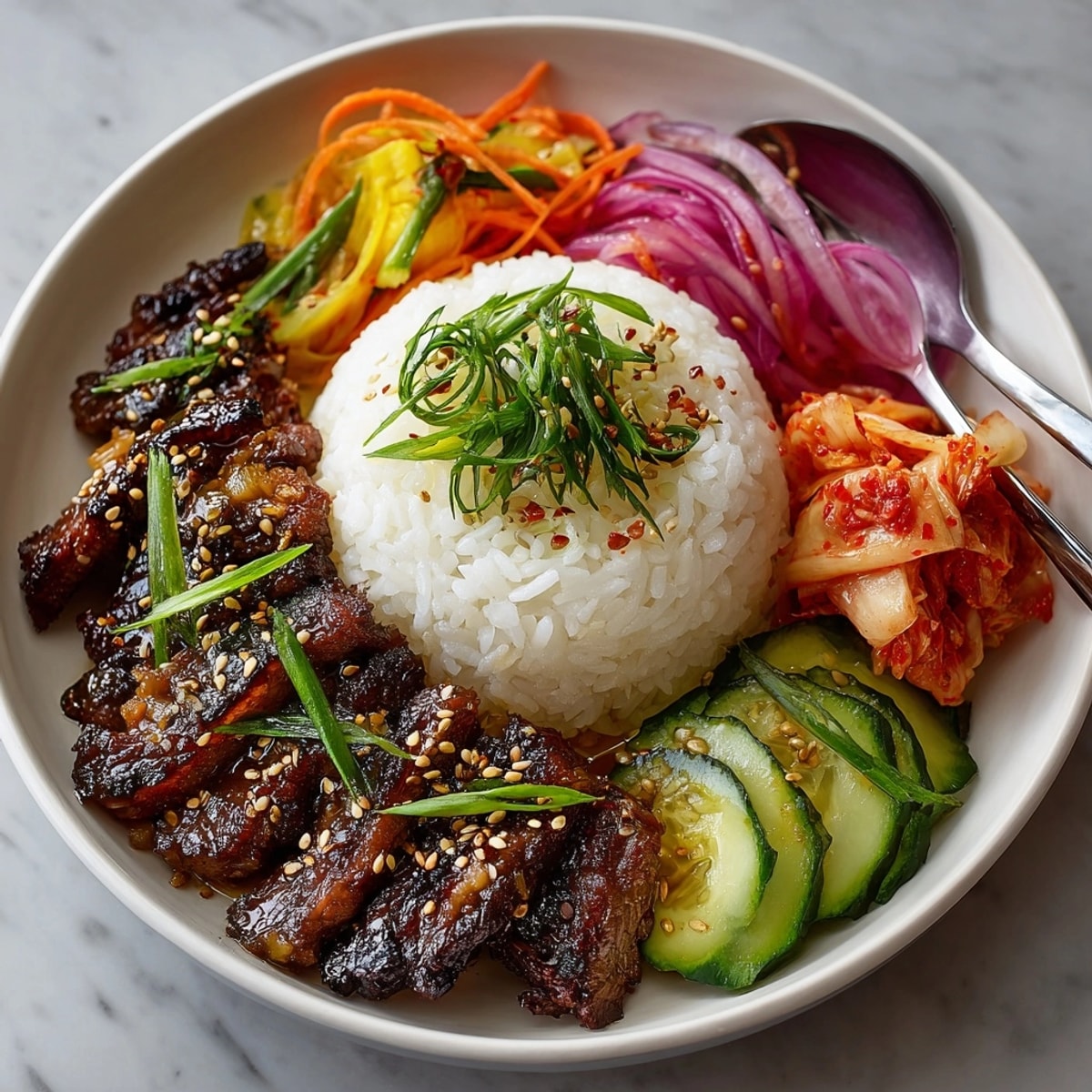 Save to Pinterest
Save to Pinterest This Korean BBQ Beef Bowl with Pickled Vegetables is that craveable dinner I turn to when I want big flavor with minimal fuss. Tender slices of marinated beef sizzle up in no time, layered over warm rice and topped with crisp pickles and a hint of heat. Every bite brings savory sweetness, tang, and a touch of spice—exactly the comfort and excitement you want from a Korean-inspired bowl.
Every time I make this for friends or family it disappears quickly and folks always ask for the recipe. That marinated beef is good enough to eat straight from the pan and the tangy pickled veggies keep each bite fresh.
Ingredients
- Beef sirloin or ribeye: Choose thin slices for tenderness and quick cooking Pick high-quality marbled cuts for the best texture
- Soy sauce: Lends umami depth Choose low-sodium if preferred for better control of saltiness
- Sesame oil: Fragrant and toasty Use pure toasted sesame oil for the richest flavor
- Brown sugar: Balances flavor and adds gentle sweetness Packed dark brown sugar gives the best caramel notes
- Garlic: Fresh cloves mean robust punch Look for plump firm bulbs with tight skins
- Fresh ginger: Lively spicy warmth Choose skin-on ginger that is heavy and has smooth skin
- Rice vinegar: Brings tang and brightens the marinade Use unseasoned for clean flavor
- Gochujang: Korean chili paste for a touch of smokiness and heat Seek out brands with simple ingredients and no fillers
- Toasted sesame seeds: Nutty crunch Toast briefly at home for extra fragrance
- Green onions: Bright fresh garnish Pick crisp green tops with no wilting
- Carrot and cucumber: Provides crispness and sweetness Choose firm colorful specimen
- Red onion: Mild bite and lovely color Pick onions that are shiny and free from sprouts
- Sugar: Sweetens the quick pickling solution Use plain white sugar for a clean taste
- Salt: Enhances and balances the vegetables Kosher salt is ideal
- Steamed white rice: Fluffy bed for all the savory goodness Jasmine or short grain offer the best texture
- Kimchi (optional): Zing and fermentation If buying check for bubbles and tangy aroma
- Nori (optional): Sea flavor Add extra umami and crispy texture
- Gochugaru (optional): Chili flake for more punch Choose bright red Korean chili powder that smells sweet
Instructions
- Marinate the Beef:
- Combine soy sauce, sesame oil, brown sugar, garlic, ginger, rice vinegar, gochujang, and sesame seeds in a bowl Mix thoroughly to dissolve sugar Add thinly sliced beef and toss so every piece is coated Cover and refrigerate for at least twenty minutes so the meat absorbs all the flavors
- Pickle the Vegetables:
- In a separate bowl whisk together rice vinegar sugar and salt until dissolved Add julienned carrot cucumber and thinly sliced red onion Toss to coat every piece evenly Let sit for twenty minutes stirring a couple of times for even pickling Drain before assembling bowls
- Cook the Beef:
- Heat a large skillet or grill pan over high heat Arrange the beef in a single layer Cook for two to three minutes per side until caramelized and fully cooked If your pan is small cook in batches to keep the beef tender and not crowded
- Assemble the Bowls:
- Scoop steamed rice into each bowl Layer marinated beef over the rice Arrange a generous pile of drained pickled vegetables on the side Spoon on a bit of kimchi if using and top with green onions nori strips toasted sesame seeds and a sprinkle of gochugaru if you like extra heat
- Serve:
- Enjoy bowls immediately while they are warm for the best texture and flavor
 Save to Pinterest
Save to Pinterest I am obsessed with quality gochujang for this bowl The right chili paste transforms the beef with its gentle heat and subtle tang When my partner and I made this for family movie night everyone raced to build their own bowl and the room filled with spicy beef and vinegar aromas
Storage Tips
Stack the marinated beef uncooked in the refrigerator up to twenty four hours ahead. Pickled vegetables hold well for up to three days in a covered container. Keep cooked rice and toppings separate and build bowls fresh just before eating to preserve the crunch and freshness.
Ingredient Substitutions
Swap out beef with boneless skinless chicken thighs or pressed tofu for a lighter option or to make it vegetarian friendly. Gluten free soy sauce and gochujang are available at most supermarkets. Any crisp fresh vegetable can join the pickles like daikon radish or thin green beans.
Serving Suggestions
Add a runny fried egg for extra richness if you love a Korean bibimbap vibe. Make it a shared meal by setting out toppings buffet style so everyone can build their own favorite combinations. A sprinkle of chopped roasted peanuts or cashews can add even more crunch and flavor.
Cultural Notes
Korean barbecue traditions inspire this bowl. Gochujang and quick pickled vegetables are Korean staples featured in many popular dishes. When my family visited Seoul we learned to always balance spicy sweet tangy and savory—exactly what makes this dish sing.
 Save to Pinterest
Save to Pinterest The marinade only gets better the longer it sits and the pickled veggies never get soggy. Make this ahead for super easy assembly whenever the craving strikes.
Common Recipe Questions
- → Can I substitute the beef with another protein?
Yes, chicken or tofu are excellent alternatives for a lighter or plant-based bowl. Marinate and cook them as you would the beef.
- → How spicy is this bowl?
The spice level depends on the gochujang and gochugaru used. Adjust amounts for a milder or hotter taste.
- → Do I need special equipment to make this dish?
No special equipment is required. A large skillet or grill pan, mixing bowls, and a saucepan or rice cooker will suffice.
- → How far in advance can I prep the pickled vegetables?
The pickled vegetables can be made up to 2 days ahead. Store them in the fridge for optimal crunchiness.
- → Is there a gluten-free option available?
Yes, use gluten-free soy sauce and check your gochujang for wheat-free labeling to make this bowl gluten-free.
- → Can I add an egg to this bowl?
Absolutely! Top with a fried or poached egg for extra richness and a classic Korean touch.